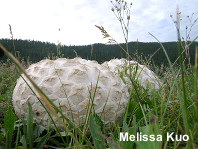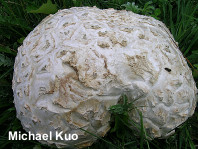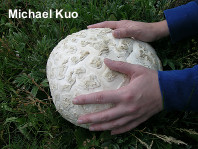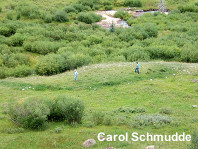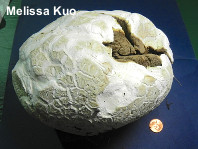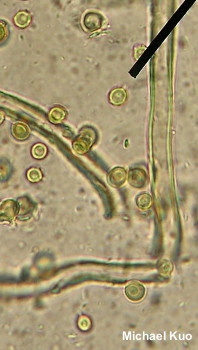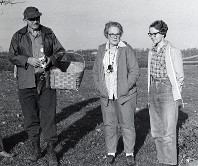| Major Groups > Puffballs > Calvatia booniana |

|
Calvatia booniana [ Basidiomycota > Agaricales > Agaricaceae > Calvatia . . . ] by Michael Kuo This western Goliath is common in the Rocky Mountains, where it can be found in near-desert conditions at low elevation or higher up, in subalpine meadows. It can reach sizes of over 60 cm across, and features a surface that is prominently sculpted with large polygonal warts. Calvatia booniana was named by mycological giant Alexander Smith in honor of William Judson Boone, the first president of the College of Idaho. Boone was a botanist and a Presbyterian minister, and he presided over the wedding of Alexander and Helen Smith. Legend has it that the requisite prenuptial class for young Alex and Helen quickly turned into an excited discussion of the area's mushrooms, and a trip to the field to see some large puffballs Boone had been watching—ironically, a fairly accurate way for the future Smiths to figure out what marriage would be like for them. A photo of the Smiths, happily married many decades later, can be found at the bottom of the right-hand column. The largest fairy ring I've ever seen was created by Calvatia booniana; enlarge the fifth illustration to get a sense of the ring's size. The darker grass represents the arc of the ring, the contours of which could be seen continuing the ring on the other side of the creek in the photo. Calvatia polygonia is a similar western species that features prominently ornamented spores and smaller dimensions (fruiting bodies measure 8–16 cm across). Calvatia gigantea is eastern North America's equivalent mammoth; it has a smooth surface. Description: Ecology: Saprobic; terrestrial; growing alone, gregariously, or in fairy rings in grassy areas or under sage brush; found at low elevation in fields and desert-like meadows, and at higher elevation in subalpine meadows; summer and fall; distributed throughout the western mountains but more common in the Rockies. The illustrated and described collections are from Colorado. Fruiting Body: Shaped like a large blob—occasionally ball-shaped and more or less symmetrical, but usually more blob-ish; 15–30 cm across and up to 30 cm high; dry; fairly bald; whitish; the surface soon breaking up into large polygonal areas; interior white and fleshy, becoming greenish yellow and eventually turning into olive brown spore dust; without a stem or basal stem-like area, but often with a small cord at the point of attachment to the ground. Odor and Taste: Not distinctive. Microscopic Features: Spores 3–5 µm; globose or subglbose; smooth or very finely roughened; occasionally featuring a short (1 µm) pedicel. Capillitial threads 5–10 µm wide; thick-walled; occasionally branched; septate; bright olive yellow in KOH. REFERENCES: A. H. Smith, 1964. (Zeller & Smith, 1964; Smith, 1975; Smith, Smith & Weber, 1981; Arora, 1986; States, 1990; Lincoff, 1992; Kreisel, 1994; Kuo & Methven, 2010; Desjardin, Wood & Stevens, 2015; Evenson, 2016; Cripps, Evenson & Kuo, 2016.) Herb. Kuo 08150707. Herb. DBG RMNP 2008-110, ROMO 2012 5024-16. This website contains no information about the edibility or toxicity of mushrooms. |
© MushroomExpert.Com |
|
Cite this page as: Kuo, M. (2017, December). Calvatia booniana. Retrieved from the MushroomExpert.Com Web site: http://www.mushroomexpert.com/calvatia_booniana.html |
